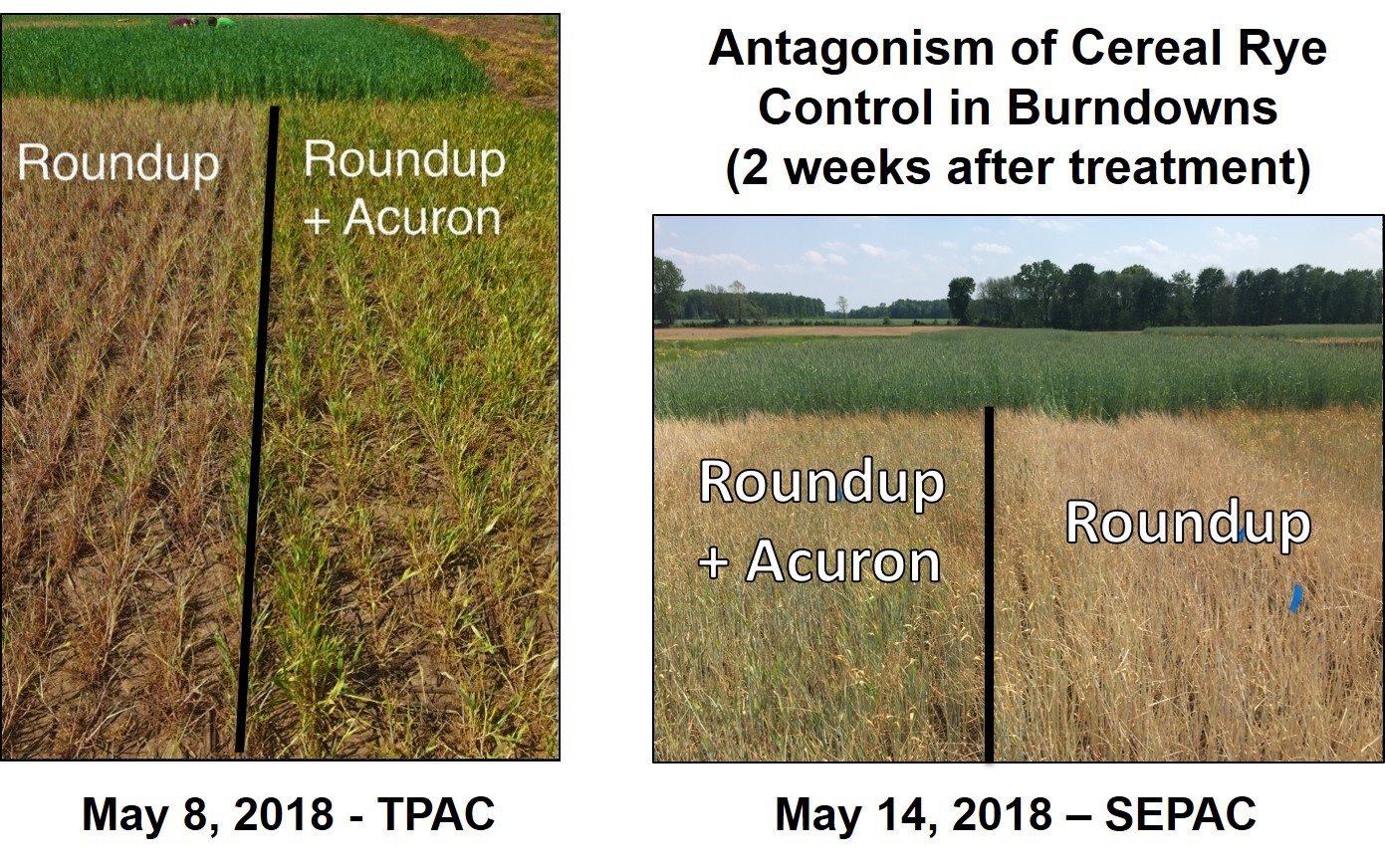Every year growers may experience challenges when controlling winter annuals weeds or terminating cover crops with glyphosate-based burndown herbicide programs, specifically when glyphosate is sprayed in cool, cloudy weather conditions or tank mixed with residual herbicides, ATS, or synthetic auxins (issue mostly for grasses). In 2018, we conducted cover crop trials at a couple locations and were able to capture some good images and weather information around those treatments. The purpose of this article is to provide some recommendations on how to achieve good herbicide efficacy during spring burndown and share our data and experiences with this situation in 2018.
We conducted cover crop experiments at three different Purdue Agricultural Centers over the last couple of years. One of the trial objectives was to look at the influence of termination timing on herbicide efficacy, weed suppression, and crop yields. Our cereal rye experiment provided a good data set to look at the influence of air temperatures on glyphosate and glyphosate plus atrazine activity. In table 1, we are showing the data for two of our sites, Throckmorton Purdue Agricultural Center (TPAC) near Lafayette Indiana and the Southeast Purdue Agricultural Center (SEPAC) near Butlerville, Indiana. In table 1 we can see the daytime high and low temperatures for the two days prior to spraying, spray day, and the next two days after that. At TPAC, you can see that the two days before spraying we had daytime air temps that got up in the 50s and 60s, But night time air temps that got as low as 29° on the day of spraying. The next two days after the spray treatment was made, our nighttime air temps got down as low as 29°. If we look at the SEPAC information, you can see that the two days before spraying, and the day of spraying nighttime air temps were down in the 30s and low 40s. The day after spraying, we had a nighttime low of 42.
In figure 1, you can see images from the two research sites. At both sites, you can see that Roundup (glyphosate) alone is providing more control then Roundup plus Acuron (atrazine + s-metolachlor + mesotrione + bicyclopyrone) at two weeks after treatment. The common thread with these results is the influence of cool nighttime temperatures on herbicide activity and the antagonistic effect of atrazine on grass control with glyphosate. For many years we focused our attention mostly on daytime air temperatures and its influence on herbicide activity. In our data set, daytime temps are mostly in the 50’s and above. However, over the last 8 to 10 years we have become more educated on the influence of nighttime air temps on herbicide activity. The moral of the story is that daytime air temperatures may seem ideal for herbicide activity, but night time air temperatures can cause plants to slow their growth rates or shut down. We know that if plants aren’t actively growing, herbicide efficacy is reduced for translocated (systemic) herbicides. Our general rule of thumb is that we want daytime air temperatures in the 50s and 60s and nighttime temperatures in the 40s or higher to assure plants are actively growing and maximize the effectiveness of postemergence herbicides.

Figure 1. Picture of Roundup alone compared to Roundup + Acuron two weeks after herbicide application to terminate cereal rye.
Table 1. Low and high air temperatures (oF) for two days before termination application to two days after application.
| TPAC Low | TPAC High | SEPAC Low | SEPAC High | |
|---|---|---|---|---|
| 2 days before application | 50 | 60 | 41 | 55 |
| 1 day before application | 39 | 50 | 30 | 59 |
| Day of application | 29 | 65 | 33 | 71 |
| 1 day after application | 29 | 65 | 42 | 80 |
| 2 days after application | 35 | 54 | 59 | 82 |
Depending on how the weather conditions develop this spring, we must also be careful about adding residual herbicides when terminating cover crops or controlling weedy grasses for a couple of reasons:
-
- If the residual herbicide is sprayed onto large amounts of biomass, the residual may never hit the ground to do its job.
- Residual herbicides sprayed under less than ideal weather conditions can antagonize glyphosate and reduce control of grasses (like wheat, cereal rye, annual ryegrass). This occasionally happens when herbicides such as flumioxazin, metribuzin, sulfentrazone, or atrazine are mixed with glyphosate. To avoid problems, increase the rate of glyphosate or spray the products separately.
- Herbicides such as 2,4-D or dicamba can be added if there are broadleaf species in the mix or if glyphosate-resistant weeds such as marestail or giant ragweed are present at cover crop termination. Keep in mind that these herbicides have preplant restrictions for soybeans unless you are planting soybean genetics such as Xtend/XtendFlex (dicamba-tolerant) or Enlist (2,4-D tolerant) or planting corn. In addition, synthetic auxin herbicides such as 2,4-D and dicamba may also reduce grass control with glyphosate; therefore, increase the rate of glyphosate to avoid problems.


